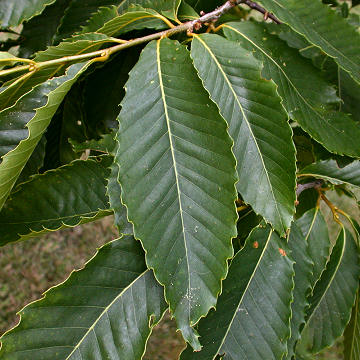

Castanea dentata - (image 1 of 7)
Taxonomy
Family: Fagaceae
Habitat
Acid, upland soils. Formerly a dominant component of eastern deciduous forests.
Associates
Distribution
New England south to FL, west WI and IA south to LA.
Morphology
Deciduous tree to 30 m. Leave oblong-lanceolate, acuminate, sharply serrate with teeth ascending or incurving. Staminate catkins elongate, axillary, to 20 cm. Fruits large, spiny, containing 2 or 3 edible nuts 1.5-2 cm, flattened on one or two sides.
Notes
Flowers appearing after the leaves
Wetland indicator: Upland (?)
Chestnut formerly made up around 50% of eastern forest trees before the introduction
of chestnut blight around 1900. The American chestnut had no resistance to the
disease and most remaining in the wild today exist mainly as living stumps that
occasionally grow large enough to flower before being killed to the ground again
by the disease. Attempts have been made to cross breed with Chinese chestnut but
the hybrid trees are not like the original chestnut. More recently, genetic
engineering is being employed to add resistance to otherwise pure American
chestnut.
References
Gleason, Henry A. and A. Cronquist. 1991. Manual of Vascular Plants of Northeastern United States and Adjacent Canada. Second Ed.
The New York Botanical Garden. Bronx, NY
USDA, NRCS. 2002. The PLANTS Database, Version 3.5 (http://plants.usda.gov).
National Plant Data Center, Baton Rouge, LA 70874-4490 USA.
|
Michael Hough © 2004 |